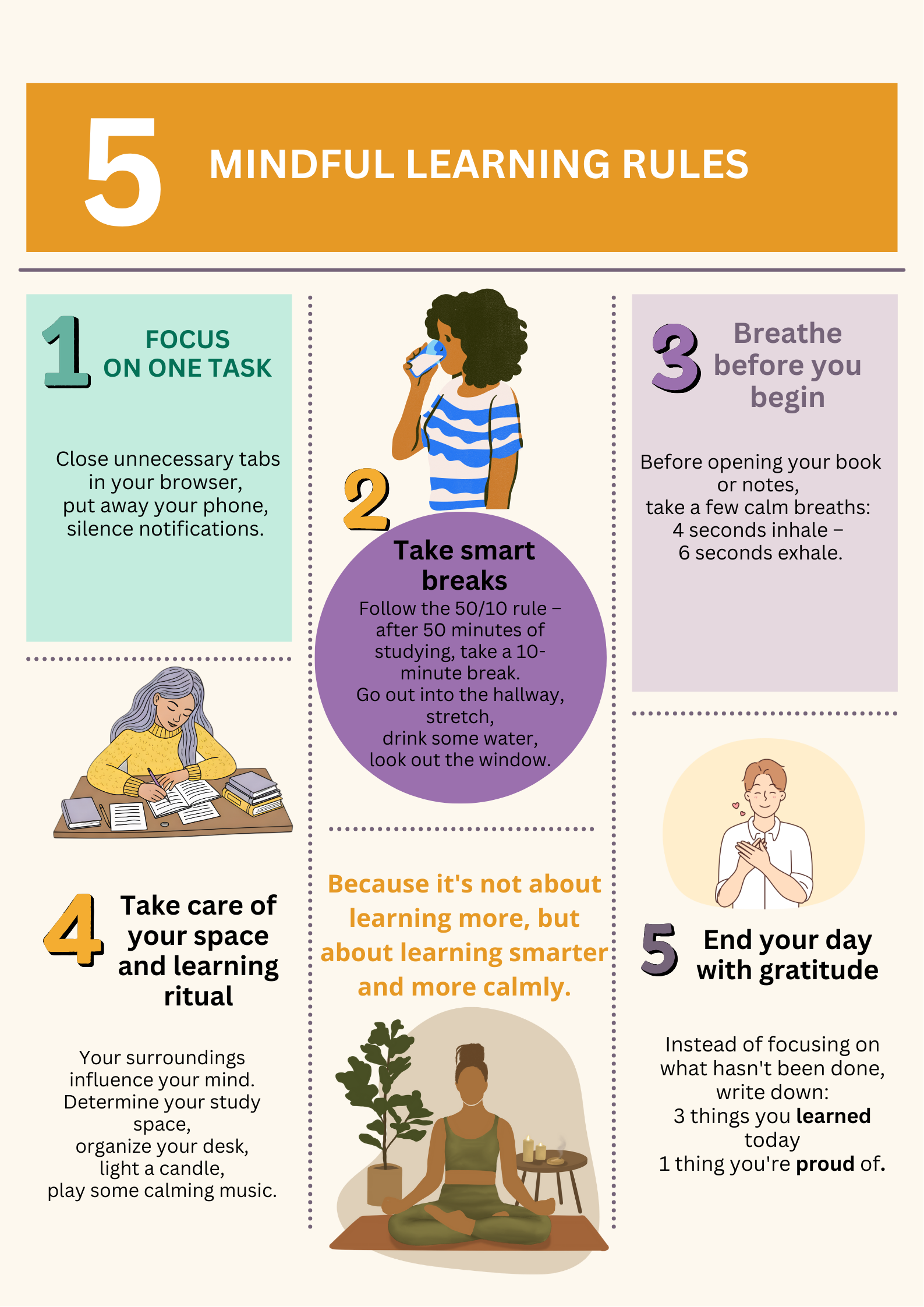TWOJA PRZEGLĄDARKA JEST NIEAKTUALNA.
Wykryliśmy, że używasz nieaktualnej przeglądarki, przez co nasz serwis może dla Ciebie działać niepoprawnie. Zalecamy aktualizację lub przejście na inną przeglądarkę.
Have you ever sat poring over notes for hours and suddenly discovered that… you can't remember what you just read?
Or that after a long day of studying, your head is steaming and your motivation has long since vanished? If so, don't worry, you're not alone. You're experiencing cognitive fatigue. Its antidote is increasingly being called mindful learning.

We live in an age where our brains are working at peak efficiency. Studying, work, social media, notifications, multitasking – all of this keeps our nervous system constantly on edge.
Research shows that the brain can only focus effectively for about 45–60 minutes. After that, concentration declines, and errors and frustration increase.
It's not laziness – it's our biology. A substance called glutamate begins to accumulate in the prefrontal cortex, responsible for concentration, causing neuronal overload. The result? Brain fog, difficulty remembering, and a feeling that "nothing else comes to mind."
Mindful learning is a combination of learning and mindfulness—the art of being fully present in what you're doing. It's not about exotic meditations, but about: noticing when you're tired, stopping before your concentration drops to zero,consciously choosing what to focus on instead of operating on autopilot. This isn't "laziness with class," but wise management of cognitive energy.
Because it allows the brain to switch between focus mode and recovery mode. It's a bit like with muscles: you can't train without a break. Similarly, the brain needs rest to consolidate knowledge and regain freshness.
Fun fact: Research from Stanford University has shown that just 10 minutes of walking outdoors increases creativity by as much as 60%. Other studies show that people who use mindfulness in their studies learn faster and remember better because they can distinguish between focused attention and mindless "repetition."
The 50/10 Rule
Study for 50 minutes – rest for 10.
Don't scroll through Instagram then – do something truly restorative: stretch, drink water, look out the window, walk down the hall.
For the brain, rest isn't a luxury; it's a prerequisite for memory.
Mindful Breathing 4–6 One task at a time
At the beginning of your study, take 3 calm breaths:
inhale through your nose – 4 seconds, exhale through your mouth – 6 seconds. This activates the parasympathetic nervous system, which reduces tension and "resets" the nervous system.
You may find that 3 minutes of breathing provides more concentration than 3 consecutive coffees.
One task at a time
Multitasking is a myth. When we do several things at once, our brain simply jumps between them, losing energy and efficiency. Try: turning off notifications, closing unnecessary tabs in your browser, planning your studying in thematic blocks. Focus is a superpower, but it must be protected like a treasure.
Offline mode for 20 minutes a day
Turn off your phone, computer, and music. Sit down and do nothing. Allow your mind to rest and "wander" through your thoughts – this is the moment when the brain combines information into new ideas. Creativity emerges where the compulsion to act ends.
End the day with gratitude
Instead of falling asleep feeling like "I still have so much to do," try writing down:
3 things you learned today,
1 thing you achieved,
1 little thing you're grateful for.
This simple exercise supports motivation and mental resilience – and learning becomes a pleasure, not just a chore.
You can also study "more mindfully" at university:
Take a 5-minute break from the screen between classes.
Introduce a minute of silence during meetings or seminars to gather your thoughts.
Organize joint academic walks – conversation and movement stimulate creativity.
In libraries, student lounges, or academic staff break areas, it's worth creating and maintaining a "refreshment corner" – a place without phones, with plants and calming music.
Taking care of your cognitive well-being isn't a fad; it's an investment in the quality of your research and teaching.

Mindful learning is not a revolution – it is a return to the natural rhythm of learning: focus, pause, reflection. In a world that is constantly accelerating, mindfulness is like an anchor – it allows us to catch our breath, regain energy, and truly understand what we are learning.
Because it's not about learning more,
but about learning smarter and more calmly.
References
Kabat-Zinn, J. (2013). Mindfulness for Beginners: Reclaiming the Present Moment—and Your Life. Sounds True. Zeidan, F., Johnson, S. K., Diamond, B. J., David, Z., & Goolkasian, P. (2010). Mindfulness meditation improves cognition: Evidence of brief mental training. Consciousness and Cognition, 19(2), 597–605. Brown, K. W., & Ryan, R. M. (2003). The benefits of being present: Mindfulness and its role in psychological well-being. Journal of Personality Dweck, C. S. (2006). Mindset: The New Psychology of Success. Random House. Dunlosky, J., Rawson, K. A., Marsh, E. J., Nathan, M. J., & Willingham, D. T. (2013). Improving students’ learning with effective learning techniques: Promising directions from cognitive and educational psychology. Psychological Science in the Public Interest, 14(1), 4–58. University of Stanford. (2014). Walking boosts creativity. Stanford News. https://news.stanford.edu/news/2014/january/walking-boosts-creativity-011414.html